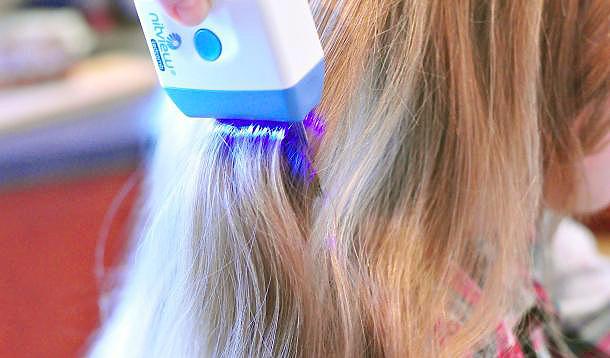
Have you ever received the dreaded letter from school informing you of a lice outbreak in your kid's classroom? It makes your head itch just thinking about it, doesn't it? Many parents are seasoned pros when it comes to dealing with runny noses, but many of us become irrational when it comes to crawling critters.
I know what it’s like to wonder why my daughter has an itch that just won’t stop, and then find lice crawling through her waist-length hair. Twice. I reacted each time as any well-adjusted, sane mother would.
BURN. EVERYTHING. DOWN!
This is my battleground:

That's A LOT of hair.
When my daughter had lice the first time, I consulted Dr. Google. He believes in covering all the bases—even ones we didn’t know existed—and he gave me a three-pronged plan of attack. I first started with a non-toxic hair wash to kill the lice and followed that up with hours and hours of combing through each strand of my daughter’s very full head of hair to seek and destroy the nits. As the third hour came to an end, my vision blurred, and I threw in the towel. But not before applying the coup de grâce (per Dr. Google) which was pouring vinegar over her head and wrapping the whole sopping mess in a tight shower cap. I’m exhausted just thinking about it. (FYI – vinegar on a scalp made raw from hours of combing and picking hurts like hell, but she’s forgiven me)
Little did I know, there was an easier, less distressing way.
After potentially traumatizing my daughter the first time, the second time head lice hit our home, I called a friend who'd fought the battle. After she virtually slapped some sense into me, she ordered me to talk to my pharmacist, who is actually more qualified than Dr. Google to give out advice. It’s easy to become distracted (and panicked) about the misinformation we find online. My pharmacist was available when I needed him and he set me straight by giving me a list of things I could do to rid our house of lice.
We've survived the battle without having to shave my own or anyone else's head because a friend cared enough to pass along info on which tools to use and which were a waste of time. Now, I braid my daughter's hair every morning, dab lavender oil behind her ears (might be an Old Wives' Tale, but I'm going with it as a preventative measure!), kiss her goodbye, and remind her not to swap hats with anyone. I may now know how to fight and beat lice, but I still hate the little buggers.


This is proudly sponsored by our friends at Nitview Ledcomb.
www.pharmachoice.com/health-advice/nitview